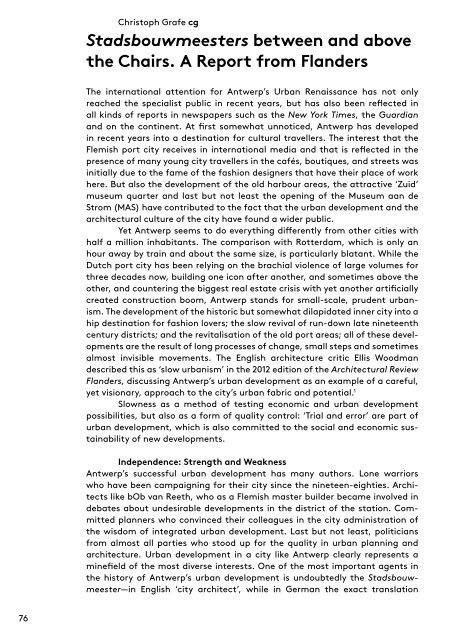Komplement und Verstaerker Amplifier and Compliment
ISBN 978-3-86859-578-9 https://www.jovis.de/de/buecher/product/komplement-und-verstaerker.html
ISBN 978-3-86859-578-9
https://www.jovis.de/de/buecher/product/komplement-und-verstaerker.html
You also want an ePaper? Increase the reach of your titles
YUMPU automatically turns print PDFs into web optimized ePapers that Google loves.
Christoph Grafe cg<br />
Stadsbouwmeesters between <strong>and</strong> above<br />
the Chairs. A Report from Fl<strong>and</strong>ers<br />
The international attention for Antwerp’s Urban Renaissance has not only<br />
reached the specialist public in recent years, but has also been reflected in<br />
all kinds of reports in newspapers such as the New York Times, the Guardian<br />
<strong>and</strong> on the continent. At first somewhat unnoticed, Antwerp has developed<br />
in recent years into a destination for cultural travellers. The interest that the<br />
Flemish port city receives in international media <strong>and</strong> that is reflected in the<br />
presence of many young city travellers in the cafés, boutiques, <strong>and</strong> streets was<br />
initially due to the fame of the fashion designers that have their place of work<br />
here. But also the development of the old harbour areas, the attractive ‘Zuid’<br />
museum quarter <strong>and</strong> last but not least the opening of the Museum aan de<br />
Strom (MAS) have contributed to the fact that the urban development <strong>and</strong> the<br />
architectural culture of the city have fo<strong>und</strong> a wider public.<br />
Yet Antwerp seems to do everything differently from other cities with<br />
half a million inhabitants. The comparison with Rotterdam, which is only an<br />
hour away by train <strong>and</strong> about the same size, is particularly blatant. While the<br />
Dutch port city has been relying on the brachial violence of large volumes for<br />
three decades now, building one icon after another, <strong>and</strong> sometimes above the<br />
other, <strong>and</strong> countering the biggest real estate crisis with yet another artificially<br />
created construction boom, Antwerp st<strong>and</strong>s for small-scale, prudent urbanism.<br />
The development of the historic but somewhat dilapidated inner city into a<br />
hip destination for fashion lovers; the slow revival of run-down late nineteenth<br />
century districts; <strong>and</strong> the revitalisation of the old port areas; all of these developments<br />
are the result of long processes of change, small steps <strong>and</strong> sometimes<br />
almost invisible movements. The English architecture critic Ellis Woodman<br />
described this as ‘slow urbanism’ in the 2012 edition of the Architectural Review<br />
Fl<strong>and</strong>ers, discussing Antwerp’s urban development as an example of a careful,<br />
yet visionary, approach to the city’s urban fabric <strong>and</strong> potential. 1<br />
Slowness as a method of testing economic <strong>and</strong> urban development<br />
possibilities, but also as a form of quality control: ‘Trial <strong>and</strong> error’ are part of<br />
urban development, which is also committed to the social <strong>and</strong> economic sustainability<br />
of new developments.<br />
Independence: Strength <strong>and</strong> Weakness<br />
Antwerp’s successful urban development has many authors. Lone warriors<br />
who have been campaigning for their city since the nineteen-eighties. Architects<br />
like bOb van Reeth, who as a Flemish master builder became involved in<br />
debates about <strong>und</strong>esirable developments in the district of the station. Committed<br />
planners who convinced their colleagues in the city administration of<br />
the wisdom of integrated urban development. Last but not least, politicians<br />
from almost all parties who stood up for the quality in urban planning <strong>and</strong><br />
architecture. Urban development in a city like Antwerp clearly represents a<br />
minefield of the most diverse interests. One of the most important agents in<br />
the history of Antwerp’s urban development is <strong>und</strong>oubtedly the Stadsbouwmeester—in<br />
English ‘city architect’, while in German the exact translation<br />
76


















